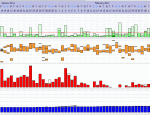Anyone have any idea what the percentage is of events sleeping on your side compared to events sleeping on your back, for the average hour in each position? I know this is highly variable for any person, and it may be only a guess, unless you have actual data from your machine or sleep study.
I am trying to estimate, or guess, what more side sleeping would do to my AHI. Thank you!
# Events on back vs side sleeping
Re: # Events on back vs side sleeping
You'll need to know pressure settings and data to make sense of this too, because people using apap machines may have similar AHIs on their backs, but at a much higher pressure.
I'm just getting started, but I go up to 16 cm H2O on my side, and I'm sure I'd need more on my back. I'm not sure it's even worth trying to sleep on that way until I'm more experienced with the mask. I haven't been able to sleep on my back (without cpap) for years.
I think odds are good that sleeping on your side will help, especially if your AHI is a little high, but the only way to tell for sure is to try it. What mask and flow generator are you using? BTW, it's a good idea to fill out the equipment section of your profile. If you do, you'll get more specific advice. Sometimes people will even tell you the answer to the question you didn't know enough to ask.
I'm just getting started, but I go up to 16 cm H2O on my side, and I'm sure I'd need more on my back. I'm not sure it's even worth trying to sleep on that way until I'm more experienced with the mask. I haven't been able to sleep on my back (without cpap) for years.
I think odds are good that sleeping on your side will help, especially if your AHI is a little high, but the only way to tell for sure is to try it. What mask and flow generator are you using? BTW, it's a good idea to fill out the equipment section of your profile. If you do, you'll get more specific advice. Sometimes people will even tell you the answer to the question you didn't know enough to ask.
_________________
| Mask: Quattro™ FX Full Face CPAP Mask with Headgear |
| Humidifier: S9™ Series H5i™ Heated Humidifier with Climate Control |
| Additional Comments: Software: SleepyHead 0.9 beta |
Download Sleepyhead here: https://sourceforge.net/projects/sleepyhead/
- Lizistired
- Posts: 2835
- Joined: Tue Dec 14, 2010 10:47 pm
- Location: Indiana
Re: # Events on back vs side sleeping
And how do you know if you sleep on your back? I thought I NEVER did, until my sleep study. Then I videoed a few nights of sleep to see if there was a coorelation. I have found that overtime, I am sleeping much more soundly, can fall asleep on my back and often wake up on my back. This was something I had hoped for because I have had chronic joint pain for years. My AHI is staying low so I think everything is coming together.
_________________
| Humidifier: S9™ Series H5i™ Heated Humidifier with Climate Control |
| Additional Comments: Swift FX sometimes, CMS-50F, Cervical collar sometimes, White noise, Zeo... I'm not well, but I'm better. |
ResScan: http://www.resmed.com/int/assets/html/s ... c=patients
ResScan Tutorial- http://montfordhouse.com/cpap/resscan_tutorial/
Machines Video: http://www.cpaplibrary.com/machine-education
ResScan Tutorial- http://montfordhouse.com/cpap/resscan_tutorial/
Machines Video: http://www.cpaplibrary.com/machine-education
- Drowsy Dancer
- Posts: 1271
- Joined: Mon Feb 28, 2011 9:35 am
- Location: here
Re: # Events on back vs side sleeping
I suppose I might, in theory, have more events on my back than on my sides, because my husband used to complain that I snored worse when on my back. So I didn't sleep on my back for years. And the conventional wisdom is that one has more events in back sleeping.
I learned, however, when I got a copy of my sleep study report that I spent the whole sleep study--two whole hours of observation and five whole hours of titration (yes, that is a faint note of sarcasm) flat on my back. I suspect I was trying to keep the huge bundle of wires from sliding off my chest. So I was theoretically already titrated for my worst-case scenario. Of course, they never got my AHI below 10 during the titration (they got rid of my apneas but not my hypopneas).
Another variable that they couldn't isolate during my particular sleep study was the effect of REM sleep. For many people apneas occur most frequently during REM sleep, but I slept so poorly during the observation part of my study that I never had any REM sleep at all in the first two hours (this is called "abnormal sleep architecture" in my sleep study report ). When they started titrating me I launched into REM sleep almost immediately and experienced "REM rebound" for a while after starting CPAP. So I don't know how to account for that variable.
Once I started on CPAP at home, I went through agonies of stiff neck and shoulders, plus leaks aplenty, trying to sleep on my side with various types of pillows. At my first followup appointment I expressed concern to my doc that I was having more events because I was sleeping on my back, and he said, "Oh. Do you want to sleep on your back? We can turn the pressure up a bit!" and that was that. He raised my pressure from 8.0 to 9.5 and my AHI decreased. (Since then I have made other refinements having to do with "comfort measures"--ramp (tried and abandoned it), C-Flex+ (kept turning it down and then turned it all the way off), humidity (have turned it up pretty high), mask (nasal pillows now) and taping (an ongoing adventure).
I now sleep flat on my back with a memory foam pillow that has a cutout for my head and neck (and side cutouts to accommodate a CPAP mask, but I don't need it), When I stay on my back the mask seems to stay in place better.
DD
I learned, however, when I got a copy of my sleep study report that I spent the whole sleep study--two whole hours of observation and five whole hours of titration (yes, that is a faint note of sarcasm) flat on my back. I suspect I was trying to keep the huge bundle of wires from sliding off my chest. So I was theoretically already titrated for my worst-case scenario. Of course, they never got my AHI below 10 during the titration (they got rid of my apneas but not my hypopneas).
Another variable that they couldn't isolate during my particular sleep study was the effect of REM sleep. For many people apneas occur most frequently during REM sleep, but I slept so poorly during the observation part of my study that I never had any REM sleep at all in the first two hours (this is called "abnormal sleep architecture" in my sleep study report ). When they started titrating me I launched into REM sleep almost immediately and experienced "REM rebound" for a while after starting CPAP. So I don't know how to account for that variable.
Once I started on CPAP at home, I went through agonies of stiff neck and shoulders, plus leaks aplenty, trying to sleep on my side with various types of pillows. At my first followup appointment I expressed concern to my doc that I was having more events because I was sleeping on my back, and he said, "Oh. Do you want to sleep on your back? We can turn the pressure up a bit!" and that was that. He raised my pressure from 8.0 to 9.5 and my AHI decreased. (Since then I have made other refinements having to do with "comfort measures"--ramp (tried and abandoned it), C-Flex+ (kept turning it down and then turned it all the way off), humidity (have turned it up pretty high), mask (nasal pillows now) and taping (an ongoing adventure).
I now sleep flat on my back with a memory foam pillow that has a cutout for my head and neck (and side cutouts to accommodate a CPAP mask, but I don't need it), When I stay on my back the mask seems to stay in place better.
DD
_________________
| Machine: PR System One REMStar 60 Series Auto CPAP Machine |
| Mask: Swift™ FX Bella Nasal Pillow CPAP Mask with Headgears |
| Additional Comments: Software: SleepyHead. Pressure: APAP 9.5 min/11 max, A-Flex x2 |
How we squander our hours of pain. -- Rilke
Re: # Events on back vs side sleeping
He's my 2cents , I don't think averages are going to mean much, have a look at your sleep study, mine showed more events on R. Side than any other position, so you might not want to assume that it is just back sleeping that is associated with more events. This may be true for many, but your results may vary. If you suspect positional problems an auto may be a n idea.
Any landing you walk away from is a good one; if you don't break your airplane it's excellent.
Re: # Events on back vs side sleeping
Can't swear I never do, but apnea keeps me from falling asleep that way, and I'm fairly sure that if I did roll to my back, I'd wake up 90% of the time. So over the years of untreated OSA, I've become trained to stay put.Lizistired wrote:And how do you know if you sleep on your back? I thought I NEVER did, until my sleep study. Then I videoed a few nights of sleep to see if there was a coorelation.
I had a persistent ear infection last fall and was putting drops in both ears for about three months. I often fell asleep with the concoction in one ear or the other, and it was always still there when I woke up. Sometimes as much as six hours later. After a while I became so confident it wouldn't spill out that I slept that way on purpose.
Hey! Thanks for reminding me that as recently as last year I could sleep six hours at a go. Maybe the brain damage isn't so bad after all.
_________________
| Mask: Quattro™ FX Full Face CPAP Mask with Headgear |
| Humidifier: S9™ Series H5i™ Heated Humidifier with Climate Control |
| Additional Comments: Software: SleepyHead 0.9 beta |
Download Sleepyhead here: https://sourceforge.net/projects/sleepyhead/
-
JimIllinois
- Posts: 104
- Joined: Sat Feb 07, 2009 3:36 pm
- Location: Illinois, USA
Re: # Events on back vs side sleeping
Sleeping on your back allows the base of your tongue to slide back and cause more obstruction, due to gravity. In addition, depending on your pillow, your head may be tilted forward, again adding to the obstruction. So, most people need a higher pressure to get the air through, while on their back. If the machine can't get high enough due to the settings, or if the machine adjusts upward too slowly, AHI numbers go up.










